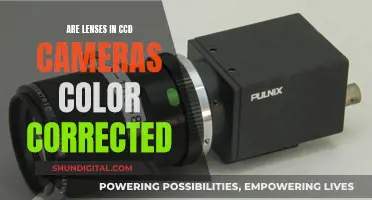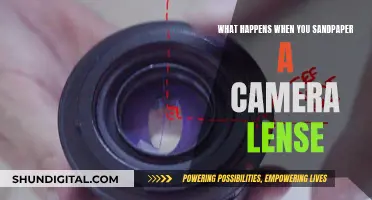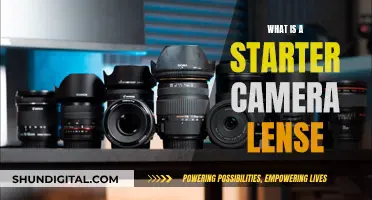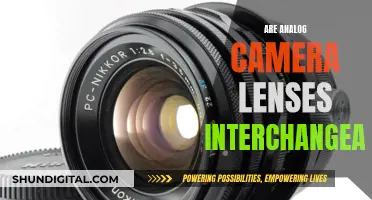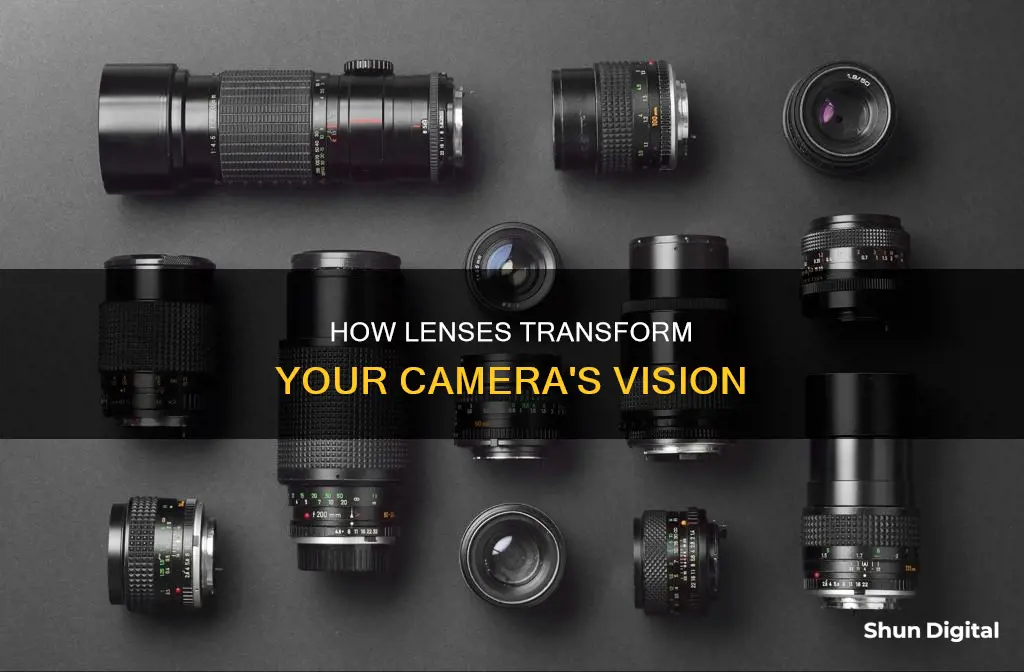
Lenses are an essential component of cameras, and their quality can make or break a photograph. A camera lens is an optical system made up of a set of shaped pieces of glass set inside a cylindrical metal or plastic housing. The lens's role is to focus light onto the image sensor or film plane, allowing light to enter and controlling how much light reaches the film to form an image. The lens's aperture governs the volume of light permitted through it, with lower stop numbers indicating a wider aperture. The lens also controls the image area or angle of view, determining the camera's field of view and magnification capabilities. Different lenses, such as zoom, prime, telephoto, and wide-angle lenses, offer photographers versatility and enable them to achieve their desired effects in their photographs.
What You'll Learn

Lenses control the amount of light that enters a camera
Lenses are an essential part of a camera. They are an optical system made up of a set of shaped pieces of glass set inside a cylindrical metal or plastic housing. The lens works like the human eye, allowing light to enter and controlling how much light reaches the film to form an image. The lens's aperture governs the volume of light permitted through it.
The lens's role is to converge light onto the image sensor or the film plane. It focuses light from what you see through the viewfinder into a tiny, typically 35mm spot on the back of your film, DSLR, or mirrorless camera. The lens controls the image area or angle of view, determining what the camera can record on the film or what it can see. The image area the lens sees depends on the focal length of the lens. Focal length is the distance from the centre of the lens, when focused on infinity, to the film plane or the area where the film rests in front of the shutter curtain.
The shorter the focal length, the wider the angle of view, and the longer the focal length, the narrower the angle of view. A longer camera lens yields a narrower view, while a wider lens spans a larger area. The lens also focuses the image onto the film. By turning the lens-focusing ring on the barrel of the lens, the glass elements move and focus the image on the film plane. Looking through the viewfinder while turning the focusing ring allows you to see if the subject you are photographing is sharp.
The lens aperture also controls the depth of field, referring to the distance between the closest and farthest objects that appear acceptably sharp in a photograph. A small aperture opening, or a large f-stop number, results in a larger depth of field, with both the foreground and background in focus. Conversely, a large aperture opening, or a small f-stop number, gives a shallow depth of field, with a sharp focal point and a soft, blurry background.
The High Cost of Camera Lenses: Why So Expensive?
You may want to see also

Lenses focus light onto the image sensor or film plane
Lenses are an essential component of a camera, and their quality can make or break a photograph. They are an optical system made up of a set of shaped pieces of glass set inside a cylindrical metal or plastic housing. The lens's role is to focus light onto the image sensor or film plane, allowing light to enter the camera and reach the film to form an image.
The lens's aperture governs the volume of light permitted through the lens. The aperture is the opening that allows light to enter and controls how much light will reach the film or image sensor. The aperture size can be adjusted by turning the aperture ring on the lens, and the different aperture sizes are called f-stops. A larger aperture, identified by a smaller f-number, allows more light to pass through the lens, resulting in a shallower depth of field. This makes it suitable for portraits or product photography, where a soft, blurry background is desired.
The focal length of a lens is another important factor. It is the distance between the camera sensor and the lens's optical centre, where light rays converge within the lens. Focal length determines the lens's field of view and magnification capabilities and is measured in millimetres. A longer focal length offers higher magnification, while a shorter focal length provides a wider angle of view.
Different types of lenses are designed for various shooting scenarios. Zoom lenses offer a range of focal lengths, making them versatile for photographers who need to travel light. Prime lenses, on the other hand, have only one focal length and do not allow for zooming in on the subject. However, they typically offer superior image quality due to having fewer lens elements and moving parts.
The quality of the lens is crucial to the resulting image quality. A high-quality lens can help capture great photos even with a cheap camera, while a low-quality lens can degrade the image produced by the best camera.
Cleaning Camera Lenses: A Step-by-Step Guide
You may want to see also

Lenses have different focal lengths
The longer the focal length, the narrower the angle of view and the higher the magnification. Conversely, the shorter the focal length, the wider the angle of view and the lower the magnification. For example, a lens with a focal length of 24mm will offer less magnification than a lens with a focal length of 200mm.
There are two types of lenses: prime and zoom. Prime lenses have a fixed focal length, whereas zoom lenses have variable focal lengths. Zoom lenses are incredibly versatile and are one of the most common types of lenses. They are ideal when you are photographing a variety of subjects, such as landscapes and portraits, and you only want to use one lens for both situations.
Prime lenses, on the other hand, are classic and have been around as long as cameras have. They produce much higher-quality images than zoom lenses but are specialised for one specific type of photography. For example, the 50mm prime lens, also known as the "Nifty Fifty", is perfect for portraits as the focal length is considered to be as close to the human eye as possible. A 35mm prime lens, on the other hand, is usually best for landscape photographers.
Lens and Camera Compatibility: Universal Fit or Not?
You may want to see also

Lenses have different apertures
The aperture of a lens is like the "pupil" of your camera system, which can open and close to change the amount of light that passes through. The aperture you choose will alter the exposure of your images by making them brighter or darker. A large aperture (a wide opening) will pass a lot of light, resulting in a brighter photograph. Conversely, a small aperture will make a photo darker. In a dark environment, such as indoors or at night, selecting a large aperture is ideal to capture as much light as possible.
Aperture also controls the depth of field, which is the amount of your photograph that appears sharp from front to back. A large aperture will give you a blurred background with a shallow focus effect, which is popular for portrait photography. On the other hand, a small aperture will give you a sharper image with a larger depth of field, making it suitable for landscape photography.
Different lenses have different ranges of aperture settings. Lenses with wide maximum apertures, such as f/1.4, are great for shallow depth of field photography. They are often referred to as "fast" lenses because they can capture more light, allowing photographers to use faster shutter speeds to take sharp photos, even in low-light environments. However, fast lenses are usually more expensive due to the complexity of their manufacturing process.
Lenses with longer focal lengths tend to have smaller maximum apertures than wide-angle lenses. This is why photographers often use wider lenses in low-light situations as they gather more light and help create sharper images.
The aperture stop is an important element in optical design, especially in photography and astronomy. It limits the amount of light that can reach the image/film plane and affects other properties such as depth of field, optical aberrations, and vignetting.
Protect Your Camera Lens: Storage Tips for Photographers
You may want to see also

Lenses can be interchangeable
Lenses are integral to photography, as they focus light from the viewfinder into a tiny spot on the camera's film, DSLR, or mirrorless camera. They are what allow photographers to capture images. Without a lens, a camera is useless, and even a cheap camera can produce great photos with a high-quality lens.
When it comes to interchangeable lenses, it's important to consider the lens mount, which is the junction where the camera meets the lens. Each major camera company uses its own proprietary mount, so a lens from one company may not fit a camera from another. For example, Canon lenses are designed to work with Canon cameras, and not Nikon or Sony cameras. However, there are third-party lens manufacturers, such as Sigma, Tamron, and Tokina, that produce lenses compatible with a wide range of camera models.
It's also important to consider the sensor size when using interchangeable lenses. There are typically two sensor sizes for interchangeable-lens cameras: full-frame and APS-C. Full-frame lenses will work on cameras with smaller sensors, but the image will appear zoomed-in. This is because the smaller sensor captures a smaller portion of the lens's image circle.
In addition, the type of camera, whether it's a DSLR or mirrorless, can impact lens compatibility. DSLR lenses can usually be adapted for use with mirrorless cameras, but the opposite is often not true due to the closer proximity of the lens to the sensor in mirrorless cameras.
When choosing interchangeable lenses, it's crucial to ensure compatibility with the camera body and sensor size. Upgrading to a new lens can be a worthwhile investment, as lenses tend to outlast camera bodies and can greatly enhance image quality.
Understanding Camera Lens Interchangeability: What You Need to Know
You may want to see also
Frequently asked questions
A camera lens is an optical system made up of a set of shaped pieces of glass set inside a cylindrical metal or plastic housing. It is mounted onto the camera and can be either interchangeable or permanently fixed.
A camera lens controls the amount of light entering the camera through its aperture and projects a sharp and undistorted image onto the film.
The aperture of a lens is the opening that allows light to enter. The different aperture sizes are called f-stops. A smaller f-stop indicates a larger aperture opening, and vice versa.
The focal length of a lens is the distance from the centre of the lens, when focused on infinity, to the film plane or the camera sensor. It determines the lens's field of view, magnification, and angle of view.
Prime lenses have a single focal length and do not allow zooming in on the subject. Zoom lenses have a range of focal lengths, making them more versatile.


